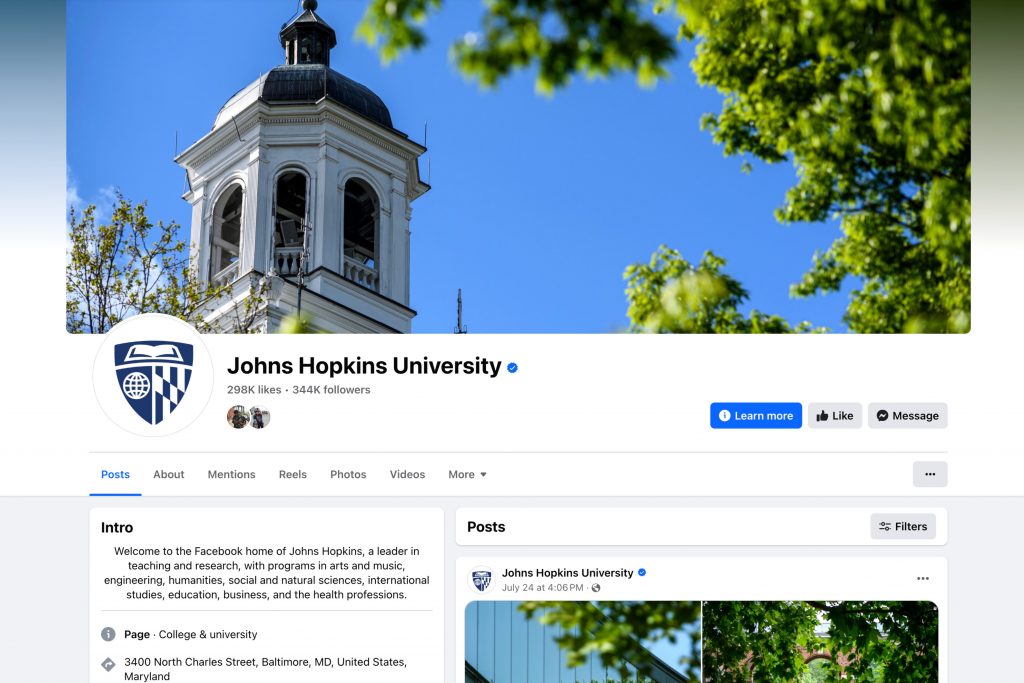
Social Media
At Johns Hopkins University, social media brings our community together through authentic storytelling, unique perspectives, and audience engagement.
As the social landscape is constantly evolving, we aim to provide clarity and support for the responsible use of social media within the university context. The following guidelines are designed for faculty, staff, and designated representatives who manage and engage on social media platforms under accounts associated with the university.
Account Types & Supported Channels
- Flagship University Accounts: Managed by the Office of University Communications at Johns Hopkins University, these accounts represent the university as a whole.
- Facebook: Aimed at providing updates, engaging content, and fostering a community among students, alumni, and prospective students.
- Instagram: Focuses on visually engaging content that highlights campus life, achievements, and events.
- LinkedIn: Professional platform used to connect with alumni and showcase research accomplishments and career opportunities.
- X (FKA: Twitter): Utilized for quick updates, sharing news, and engaging in real-time communication during university events and more.
- TikTok: Utilizes engaging, short-form video content to highlight campus events, student life, and informal educational content to connect with a younger audience.
- Johns Hopkins-Affiliated Accounts: Operated by various schools, divisions, departments, or units within Johns Hopkins and representing those entities specifically.
- Personal Accounts: Created and maintained for personal use; they do not reflect the university’s views or values. The following guidelines do not apply to personal social media accounts operated by individuals for private use.
Best Practices for Social Media Management
Social media is a two-way conversation that requires strategic planning and regular engagement. A comprehensive social media strategy should encompass content dissemination, listening and responding to public concerns, and incorporating audience feedback into communications. Consider the following guidelines as you manage your account:
Guidelines
Creating a New Account
Engagement & Community Management
Accessibility & Inclusivity
Success Metrics & Analytics
Security & Privacy Considerations
Respecting University Policies
Naming & Visuals
Your account name and profile images should be consistent and aligned with Johns Hopkins University across all platforms you manage a social media presence.
Account Names & Handles
When naming your social media account, it’s crucial to ensure it aligns with the Johns Hopkins University brand, making it easily identifiable and searchable. You should aim to include relevant keywords related to your department or program in your channel name to enhance discoverability by target audiences. To align with the JHU brand, account names should also include “Johns Hopkins” or “Johns Hopkins University.” If space is limited, “JHU” may be used, but acronyms should generally be avoided.
Additionally, on some platforms, your account will have a handle (@accounthandle). Users will see this when your content appears in their “feed,” while your full account name is available if they view your profile. Your account’s handle should mirror your account name, if possible, though handles often have shorter character limits.
Avatars & Profile Images
Your avatar or profile image serves as a visual representation of your channel and the Johns Hopkins University brand. Remember, your profile image will never appear without your account name, so it’s unnecessary to include your unit’s name in the image, plus text in these images would likely be too small on a mobile device for users to see. Keep your avatar consistent across all platforms to enhance brand recognition and only update it to reflect major branding changes or during significant universitywide campaigns.
To create a consistent look and build trust among our audiences, we recommend using one of the following avatars for all official flagship and Johns Hopkins-affiliated social media platforms. If you choose to create your own profile image, keep in mind that primary logos, lockups, spirit marks, and secondary graphics (unit accent graphics, event graphics, etc.) cannot be used.

Style A
Reserved for official division and flagship accounts. Can be customized with division shields. Request template from [email protected].

Style B 
Available for use across the institution. Can be customized with division shields, brand patterns, or subtle, unit-specific backgrounds.
Access Style B Template
Style C 
Available for use across the institution. Can be customized with division shields, tag color, and unit-specific photograph.
Access Style C TemplateCover or Channel Images
Cover or channel header images provide a dynamic visual space to highlight key university themes, events, or campaigns.
- Size: Recommended dimensions vary by platform—always adhere to the specific platform requirements to ensure proper display.
- Content: Use high-quality images that represent the university—these can include campus shots, event photos, or approved graphics relevant to current initiatives.
- Consistency: Unlike avatars, cover images can be changed more frequently to highlight current events, seasons, or achievements.
- Accessibility: Ensure text is minimal and readable, using large fonts and sufficient contrast. Avoid placing critical textual information in areas likely to be cropped on different devices.

CONTENT Creation
Photos & Video
Photos and videos, as compared to graphics and text, perform better on social media and should be prioritized on your channels, unless there is a strategic need to do otherwise. Always make sure you’re using high-resolution images and videos with appropriate edits for clarity and branding. University Communication’s multimedia team keeps our photo library up to date with the latest images from around campus. You can pull from these shots or create your own. We advise avoiding AI-generated imagery on social media as these are platforms that value authenticity and “real-life” content.
Graphics
We recommend limiting graphics on social media in favor of photos and videos. However, if graphics are strategically necessary for your unit’s communications plan, please ensure they are designed according to brand guidelines (e.g. correct colors, fonts, icons, etc.). You can access graphic elements and approved marks in our Download Library, but keep in mind that it is not necessary or encouraged to include your unit’s logo on each of your posts. Users view posts in the context of your profile and their feed, so your profile image and account handle do the job of branding for your unit.
To support the creation of engaging and on-brand social media content, we recommend the following professional tools:
Voice & Tone
Our social media communications reflect our dedication to excellence, opportunity, and impact in alignment with the university’s messaging standards.
Excellence
Our content is bold, professional, and clear. It adheres to editorial guidelines and AP style, with adaptations for social media specifics like character limits. We prioritize active voice, avoid clichés and jargon, and meticulously check spelling and grammar.
Opportunity
We maintain a positive and supportive tone, sharing content that fosters connection and pride and enhances the academic, social, and professional experiences of our students, alumni, faculty, and staff. We use exclamation points sparingly to convey excitement.
Impact
We focus on demonstrating the tangible local and global effects of our academics, research, and community efforts. Each post is crafted to answer, “Why does this matter and to whom?” and includes calls to action that engage our audience more deeply.
Emojis
Use to add emphasis or tone, particularly in lighter communications. Be mindful of accessibility for those using screen readers.
Check out our favorite emojis:
- Bird: 🐦
- Blue Hearts: 💙 🩵
- Wing: 🪽
- Nest: 🪺
- Globe: 🌎
- Lacrosse: 🥍
- City: 🏙️
- Graduation Cap: 🎓
- Blue Book: 📘
Hashtags
When incorporating hashtags into your social media posts, it is crucial to follow these guidelines to ensure they are effective and relevant to your audience.
Use Sparingly
Hashtags are designed to group related content, making it easier for users to find posts on specific topics. However, if you are the only one using a particular hashtag, it serves little purpose. Limit your use of hashtags to those already widely used and relevant to your content.
Conduct Research:
Before adopting a non-brand hashtag, take the time to research it. Search for the hashtag to see what type of content it is associated with and ensure it aligns with your message. This helps maintain the integrity and relevance of your post.
Prioritize Accessibility
For better readability and accessibility, keep your hashtags concise (e.g., #JHU). Capitalize the first letter of each word in multi-word hashtags (e.g., #JohnsHopkinsUniversity) to improve legibility.
Understand the Audience
While the popularity and functionality of hashtags have evolved, they still resonate strongly with some of our long-time followers. Recognize the demographic of your followers and tailor your hashtag strategy accordingly to maximize engagement.
Mentions
Tag relevant, active accounts without including controversial content. To build community and extend your content’s reach, it’s best practice to mention other university-affiliated and flagship accounts in your posts. If your handle is tagged by another JHU account, interact with the post by liking or commenting to boost reach!